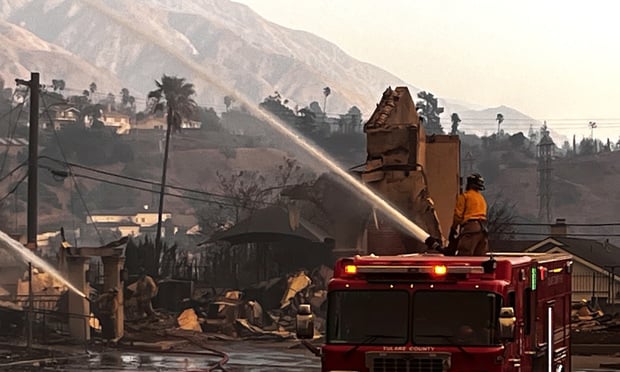Can Mold Be An Insurable Risk Again?
Fire retardant maker says inhibitor should ease builders' liability insurer concerns
Homebuilders may soon be offered a chance to spray and paint on exceptions to mold exclusions in their liability insurance policies, according to an executive of a company that makes a mold inhibitor.
Although no insurance company has actually removed a mold exclusion from a contractors or homebuilders liability policy yet, Ken Rusk, president of No-Burn in Toledo, Ohio, said his firm's products--No-Burn MIH and WoodGuard MIH--can ease homebuilders' insurance concerns in several ways.
First, the products--which essentially are fire retardants that can be applied to drywall and wood--have been enhanced to limit mold growth. "If you have existing mold, we don't say we'll kill it," but it will encapsulate mold and stop it from growing, he explained, contending that while there are other mold inhibitors on the market, No-Burn's patented products are the only non-carcinogenic, non-toxic products that stop both fire and mold.
"In our testing, we didn't just put wood and drywall in water and wait for mold to grow," he said. Instead, testers smeared "thousands of mold spores" on treated samples of wet wood and drywall. "We put five years worth of horrendous possible mold situations into the test and accelerated it. There was zero-mold growth," he said.
"It's possible that a manufacturer like No-Burn would be better off if insurers did not get back in the business of offering coverage, said Steve Shechter, president of the Evans Insurance Agency in Akron, Ohio, noting that the absence of mold coverage could be a motivator for contractors to want to buy the inhibitors.
On the other hand, if a builder is able to obtain liability coverage because the builder has agreed to have the products applied on a construction project, that could also be an incentive, he said.
The two explained that one insurance-related benefit currently available with the purchase of No-Burn's products is an insurance-backed warranty covering homebuilders (of single-family homes and multi-family apartments and condominiums with 16 units or less) for up to $50,000 in mold remediation costs.
Mr. Rusk said that an international insurer backs the seven-year warranty, but said he didn't have permission from the A-rated offshore carrier to reveal its identity.
"Many builders can't get [mold] coverage," he said, likening the situation to driving a car without insurance. "They're just waiting to get nailed by a huge mold claim," he added, noting that some builders set aside funds for potential claims.
"We have a way to eliminate that. All they have to do is use our product in the home, and we take on that mold warranty for them," he said. "We want people to know it's not just a local guy offering a warranty that isn't going to be worth anything if something happens," he added, explaining the reason the firm sought an insurance company to back the warranty.
"Our goal is to prove that mainstream insurers should take this on," he said. "We don't think that an insurer should back a builder without any protection for mold. We understand why they're not. But if you purposely spray a home to eliminate mold, that should be insurable again."
Mr. Schechter's involvement with No-Burn began when he was called upon to place product liability coverage for the firm. His agency is now the partial owner of North American Safety and Preservation Associates--an organization dedicated to raising the insurance industry's awareness of technologies that save lives and reduce losses, which has No-Burn as its first client.
"Recognition by the insurance industry is key," Mr. Shechter said, noting that at $1 to $1.50 per square foot, the cost is not inexpensive. "It's desirable for the insurers to understand what this does so they can price the risk accordingly."
While Mr. Rusk said insurers are considering 20 percent discounts on liability coverage for homebuilders who use the No-Burn products, Mr. Shechter was unable to confirm this. But Mr. Shechter did say that he is working with a standard carrier that is set to roll out an enhancement to a contractors' liability program--a $150,000 mold sublimit. (He declined to reveal the name of the carrier, noting that negotiations with the insurer are still in progress.)
"These things take a long time," said Mr. Shechter, who recounted efforts to get insurers to understand the "intumescent" fireproofing technology of the No-Burn products, and how intumescent fire-retardant coatings (IFRC) stack up against fire-retardant treated (FRT) lumber.
He said that a very recent success for No-Burn on the personal lines side marks a huge step for the insurance industry. Motorists Insurance Group attended a live-burn demonstration and decided to offer a 15 percent discount on homeowners' premiums in several states, he said, noting that NASPA recently presented the insurer with a plaque to recognize its efforts.
"The fact that they took this step means we are no longer in the business of trying to encourage somebody to be first," he said.
Mr. Shechter noted that the Insurance Services Office recognizes FRT as noncombustible material--making buildings constructed with it eligible for lower premiums. He added that a recent test by an accredited lab found that IFRC outperformed FRT in preventing fire damage, suggesting that No-Burn's products could someday become more widely recognized by the insurance industry for property premium discounts.
A video of a comparison test performed by NASPA can be viewed at www.noburn.com/video.asp or www.nasafety.org (Click on "No-Burn Coatings vs. Impregnated Wood.")
Art Caption
Applying a mold inhibitor not only limits mold growth, but two such products sold by No-Burn come with an insurance-backed warranty for $50,000 in mold remediation costs--easing some concerns about mold exclusions in homebuilders' liability policies.
Fast Fact
According to the Insurance Information Institute, the average homeowners mold claim costs $15,000 to $30,000 to handle.
Worth Noting!
While mold is almost universally excluded from contractors' liability policies, at least one carrier--American International Group--offers a Contractors Pollution Liability Policy which covers mold and other environmental issues.
While "mold is at the forefront," John O'Brien, executive vice president and chief operating officer of AIG Environmental, explained that contractors working on former contaminated properties can spread contaminated soil or puncture an underground storage tank to exacerbate existing environmental conditions.
Want to continue reading?
Become a Free PropertyCasualty360 Digital Reader
Your access to unlimited PropertyCasualty360 content isn’t changing.
Once you are an ALM digital member, you’ll receive:
- Breaking insurance news and analysis, on-site and via our newsletters and custom alerts
- Weekly Insurance Speak podcast featuring exclusive interviews with industry leaders
- Educational webcasts, white papers, and ebooks from industry thought leaders
- Critical converage of the employee benefits and financial advisory markets on our other ALM sites, BenefitsPRO and ThinkAdvisor
Already have an account? Sign In Now
© 2025 ALM Global, LLC, All Rights Reserved. Request academic re-use from www.copyright.com. All other uses, submit a request to [email protected]. For more information visit Asset & Logo Licensing.








